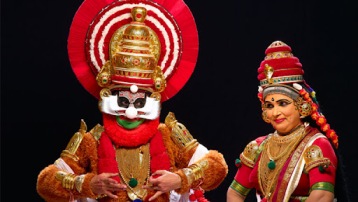 16th August, 2021
16th August, 2021Southern state of India, Kerala is known for its rich diversity of art forms. Way back in 1930 Mahakavi Vallathol established Kerala Kalamandalam and introduced two distinct classical dance styles of India, namely Kathakali and Mohiniatam, that enthralled European audiences with the performances by Kalamandalam dancers led by the great poet. While two classical dances gained international recognition, there are several other art forms of Kerala, that are comparatively lesser known.
Here are some of the art forms that captures the attention of the common man. The article is dedicated to three devoted performers I had met personally, namely veteran Koodiyattam artiste Mani Madhava Chakyar, Mumbai based Chakyarkoothu artiste K.K.Rajan and Ottam Thullal artiste Kalamandalam Geethanandanam who literally collapsed on stage during a performance at a young age.
KOODIYATTAM
Koodiyattam is considered the mother of Kathakali and also the greatest form of Sanskrit theatre that led to the development of the dramatic art form of Kerala, namely Kathakali. Koodiyattam literally means dancing together and is also based on the ‘sastras’ and the language of hand gestures is derived from Hasta Laksha Deepika and is the original form of dance, drama and theatre. Kathakali is considered the refined and decorated form of Koodiyattam that again portrays stories of Hindu Mythology in a dramatized manner. The costume and make-up of Koodiyattam is comparatively more simpler, Kathakali moves forward with stylised make-up and costumes that changes according to the character portrayed.
CHAKYAR KOOTHU
Chakyar Koothu for generations has been performed by the traditional family of Chakyars. Chakyar and Nangiars are particular community of Kerala who have devoted their lives towards the propagation and promotion of this unique performing art known as Chakyar Koothu. The artiste is attired is a strange style, that practically symbolises the bird and also gives a comic touch to the personality of the artiste. The artiste is also known as a court jester or “vidhushak” who has a distinct role to perform. While narrating varied stories from epics, the performers also portrays,enacts and narrates varied ills of the society that needs to be corrected for the betterment of the society and welfare of the people.
During the days of royal patronage, it was not easy for common man to reach out to the king, hence the common people would face several problems regarding survival and are also exploited by rich landlords or feudal lords.hence this art form was used as a social corrective, so as to attract the attention of the king. While narrating the stories with wit and humour, they would be related to the contemporary society and at times make fun of people from the audience with a different context. While Chakyar Koothu is performed by men, Nangiar Koothu is performed by women.
OTTAM THULLAL
As the name suggests Ottam means running and Thullal means playing, in other words Ottam Thullal is a playful dance with entertainment and message too with lot of pun and satire. Kunjan Nambiarwas a great promoter of this art, who also composed the lyrics in Malayalam which can be understood by the common man, for instance “Ottam Thullalthulli Verumbo, Veetil Kanni KudinkyanIlliya, Ethere Valliye Vanna Thadiyan, Yedenna Kollam, Yendena Kollam, Ullokeya Polay Oru Thannine Kollam” (After the Ottham Thullal performance, the artist returns home but has no food to eat, what is the use of being such a big man when he is unable to take care of his basic needs). Known as the poor man’s Kathakali, the make-up, costume and technique of performance is comparatively quite simple.
THEYYAM AND PULI KALI
Theyyam is a ritualistic dance art form.Wherein pantheistic deities are summoned to the body of the performer. The performers mainly men perform in “kaavu”(small rain forest) manifesting varied aspects of nature, hence the performers are decorated with leaves, garlands, flowers and fruits. The headgear is really big and personifies the ritual, for instance in Chamundi Theyyam, it is the goddess who is invoked. Particularly prevalent in North Malabar, there are several types of Theyyam and performed near the temple. There are particular communities that follow this custom with strict adherence.
Puli Kali as the name suggests is the play of the leopard or tiger, hence attired with masks and completely coloured like the tiger. Performed by men, women and children during festivals like Onam. Potbelly men practically shake their belly which is painted with the face of the tiger, hence this art form has more of recreational value of fun and frolics and is quite prevalent in Thrissur district.
By Guru Vijay Shanker
Guru Vijay Shanker is a professional Kuchipudi-Kathakali exponent, dance teacher, choreographer, actor and arts critic for over four decades. He can be contacted through email: vijaydance@gmail.com
